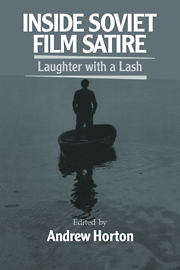Book contents
- Frontmatter
- Contents
- Foreword: If life itself is a satire …
- Acknowledgments
- Editor's note
- Introduction: Carnival versus lashing laughter in Soviet cinema
- Part One The long view: Soviet satire in context
- I Soviet film satire yesterday and today
- II A Russian Munchausen: Aesopian translation
- III “We don't know what to laugh at”: Comedy and satire in Soviet cinema (from The Miracle Worker to St. Jorgen's Feast Day)
- IV An ambivalent NEP satire of bourgeois aspirations: The Kiss of Mary Pickford
- V Closely watched drains: Notes by a dilettante on the Soviet absurdist film
- Part Two Middle-distance shots: The individual satire considered
- Part Three Close-ups: Glasnost and Soviet satire
- Filmography
- Contributors
- Index
III - “We don't know what to laugh at”: Comedy and satire in Soviet cinema (from The Miracle Worker to St. Jorgen's Feast Day)
Published online by Cambridge University Press: 07 October 2009
- Frontmatter
- Contents
- Foreword: If life itself is a satire …
- Acknowledgments
- Editor's note
- Introduction: Carnival versus lashing laughter in Soviet cinema
- Part One The long view: Soviet satire in context
- I Soviet film satire yesterday and today
- II A Russian Munchausen: Aesopian translation
- III “We don't know what to laugh at”: Comedy and satire in Soviet cinema (from The Miracle Worker to St. Jorgen's Feast Day)
- IV An ambivalent NEP satire of bourgeois aspirations: The Kiss of Mary Pickford
- V Closely watched drains: Notes by a dilettante on the Soviet absurdist film
- Part Two Middle-distance shots: The individual satire considered
- Part Three Close-ups: Glasnost and Soviet satire
- Filmography
- Contributors
- Index
Summary
Without laugher, comedy is impossible. It's difficult to make a Soviet comedy because we don't know what to laugh at.
Osip BrikEarly Soviet cinema had many triumphs, but few comedies are typically counted among them. My purpose here is not, however, to recite a litany of failures, but rather to look at the few successes and to explore the reasons why the genre faced such formidable obstacles. While comedy was by no means the only troubled genre in Soviet silent cinema, an examination of the evolution of comedy has exceptional potential to illuminate issues important in understanding the transformation of Soviet society in the 1920s: the cultural and political elites' disdain of mass opinion, their puritanical bias against entertainment, and the incipient authoritarianism implicit in their efforts to turn a cinematic culture into a political culture. These tendencies, moreover, were quite apparent before the Cultural Revolution of 1928–32. By 1927, as Brik's words indicate, the USSR was a society where even humor had to be “managed.”
Before turning to a discussion of the scientific problems of film satire and comedy during the 1920s, we need to keep certain aspects of the cinematic context in mind. Although cinema had been nationalized in 1919 and placed under the control of the Commissariat of Enlightenment (Narkompros), this control was actually nominal for most of the decade due to deep divisions within the commissariat about the function of cinema in a Socialist society.
- Type
- Chapter
- Information
- Inside Soviet Film Satire , pp. 36 - 47Publisher: Cambridge University PressPrint publication year: 1993
- 2
- Cited by

